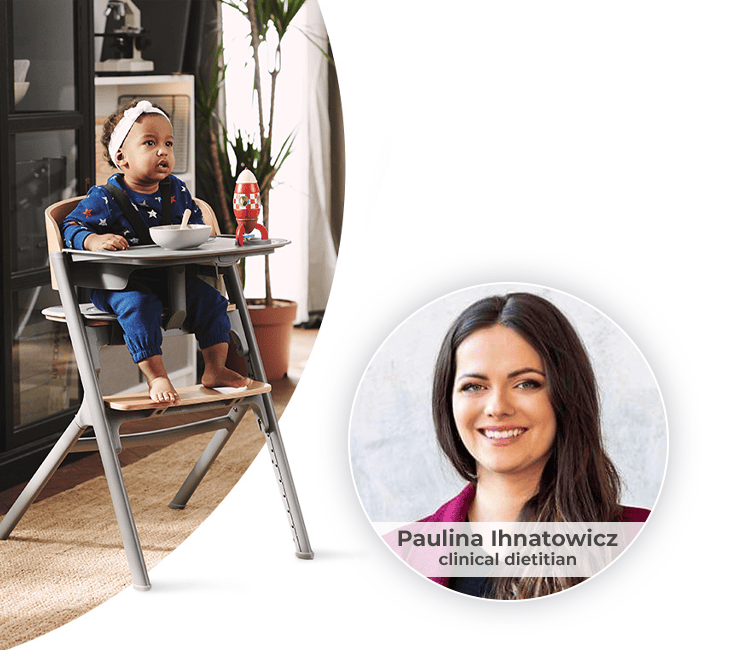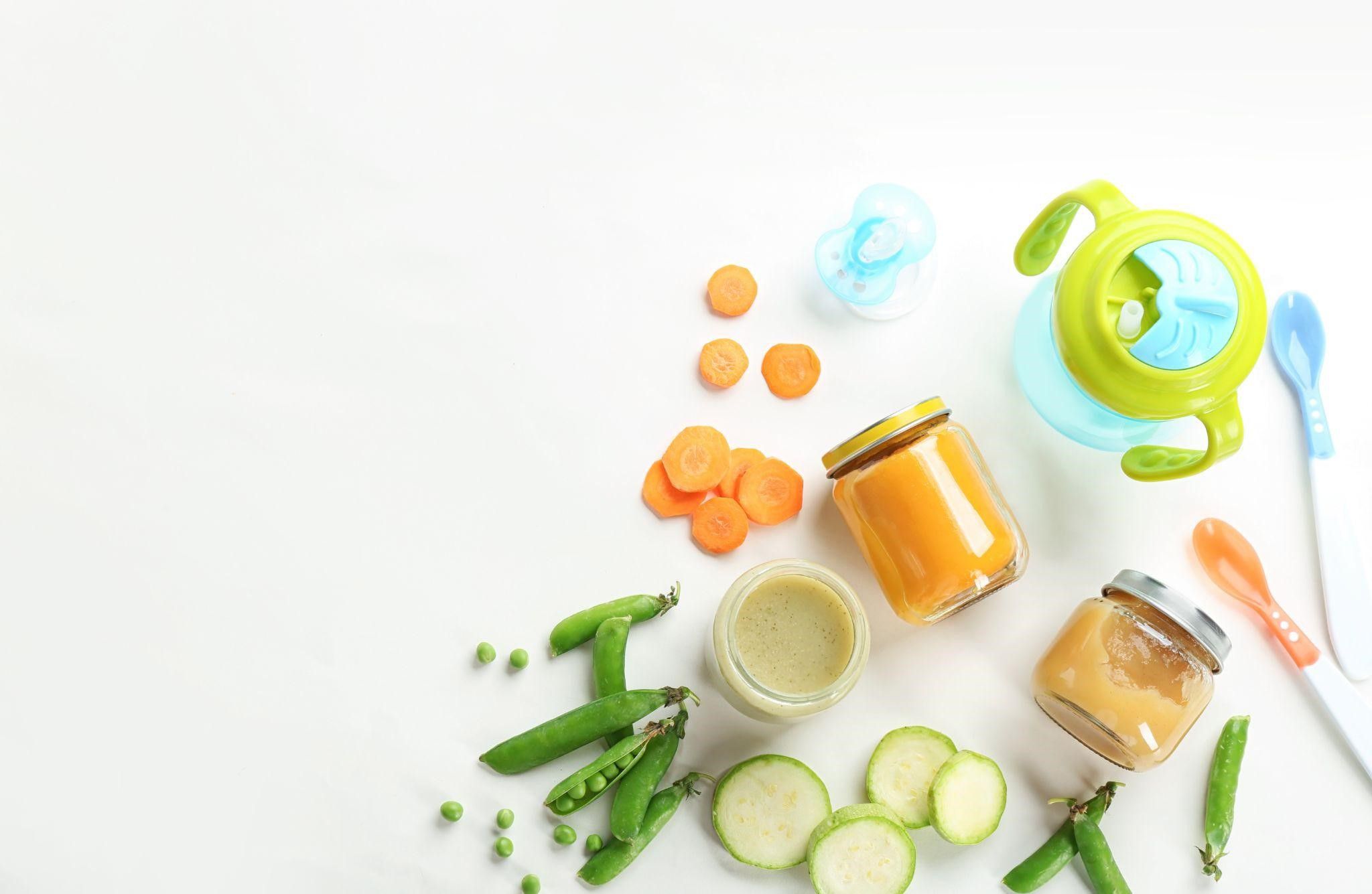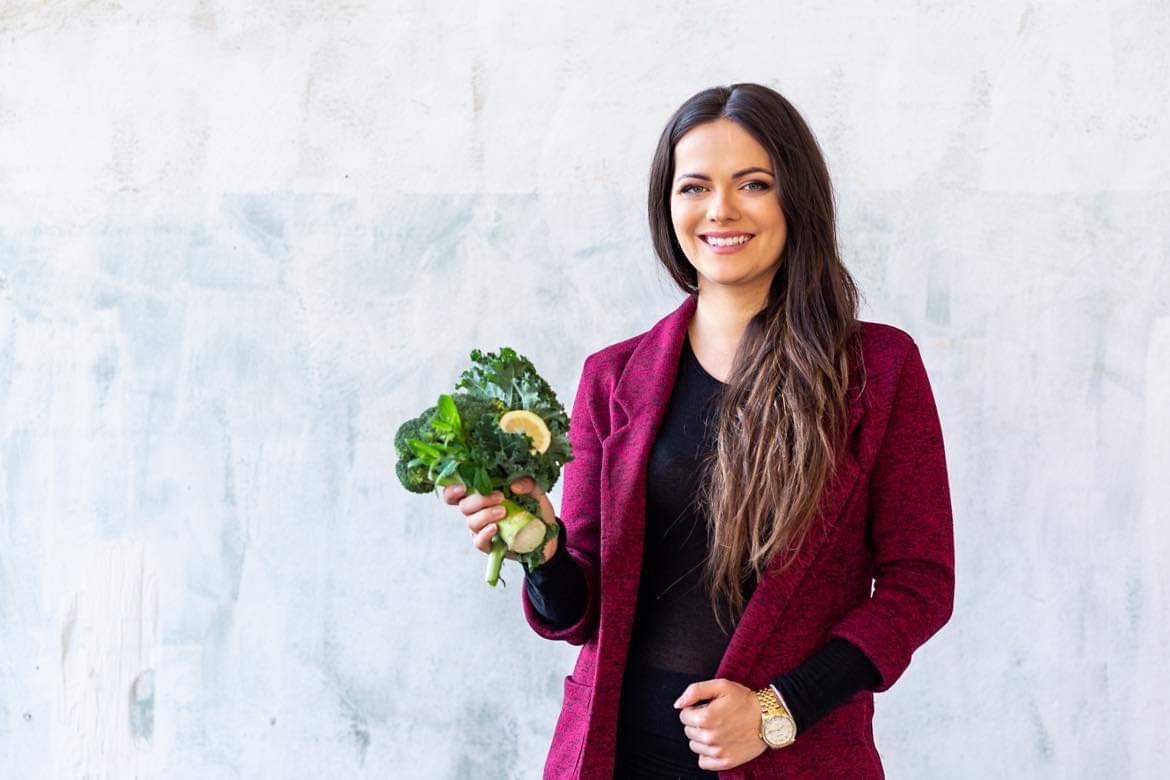Expanding your child's diet – everything you need to know

There are many myths about expanding a child's diet. Once your child is six months old, you start to wonder, "Is it time?" Or perhaps the diet should've been expanded earlier? Are jars OK, or should I cook the food myself? Or maybe I should try the BLW method? In this article, we'll dive deep into the topic of expanding your baby's diet, and together with Paulina Ihnatowicz, debunk some myths about this topic.
When should you expand your child's diet?
This is probably one of the first questions you'll have. Different sources say different things – some recommend adding variety to the baby's diet from four months, while others from six. On baby food jars, it often says that purées can be given to babies from four months. What's the truth?
When can you start thinking about expanding your little one's diet? What should you start with?
Paulina Ihnatowicz: In accordance with the World Health Organization's guidelines, a child's diet should expand after six months. On the other hand, the recommendations of the Polish Society of Gastroenterology, Hepatology and Children's Nutrition state that this should be done once the baby demonstrates developmental skills that enable food consumption, which is usually not earlier than 17 weeks (the beginning of the fifth month) and not later than 26 weeks (the beginning of the seventh month). The WHO guidelines also specify that breastfeeding may (but doesn't have to) be continued until 24 months.
In addition to the official recommendations you should follow, it's worth highlighting that the child's age is not the only determinant. You should also take into account their development: are they sitting confidently, are they interested in food, do they keep the food in their mouth rather than spitting it out?
What should you start with when expanding your baby's diet?
Paulina Ihnatowicz: The official recommendations don't clearly specify which products should be introduced in what order. It is said that vegetables should be first, but parents often introduce fruits first, due to their sweet taste. When bringing in vegetables and fruit to the diet, it's good to use what's seasonal. You can try carrot or potato if you're starting to expand your youngster's diet in summer, or pumpkin or beetroot if it's autumn.
Can the child be not ready to expand their diet?
Paulina Ihnatowicz: Yes. You should take note of their skills. Signs that your little one is ready to include that they're not pushing the food out with their tongue or spitting it out. If this is happening, you can wait a little longer before trying again. Of course, you should introduce foods when the child is able to chew and you're able to see this. The next sign is the ability to grip, as well as interest in solid foods.
Other important aspects are the child's ability to sit confidently, which means they shouldn't be falling backwards, and the youngster being able to easily guide the food into their mouth.
Readiness for expanding the diet
As Paulina Ihnatowicz mentioned above, the baby must demonstrate that they're ready to expand their diet. The ability to sit confidently, unaided, is a very important skill. But some parents try to expand the diet by placing the child on a bouncer or supporting them with pillows.
Never support your child with pillows if they're unable to sit unaided! Accelerating this natural skill may seriously harm your youngster's development. If you're worried about something, go and see a paediatrician, who will examine your baby and, if needed, refer you to a physiotherapist.
Sometimes, six-month-old children aren't able to sit up completely unaided. If you're working on this with a physiotherapist, when expanding the diet, you should start with puréesand a high chair-bouncer, which will enable you to discover new flavours. A great option for this is LIVY – a high chair that can be converted to a high bouncer. It'll make it easier to feed your little one.
Remember to only give really small amounts – just enough so your child can taste them! Never give your baby solid foods in a bouncer, as they pose a risk of choking!
LIVY with a bouncer is easy to clean if your youngster does push out some food with their tongue. When the child learns to sit unaided, you can easily transform it into a high chair. It has a special silicone insert, which is dishwasher safe. It'll definitely come in handy when your little one starts grabbing the spoon off you!

Home-made or shop-bought?
The availability of jars with ready-made purées revolutionised contemporary parenting, including expanding the child's diet. Ready-made jars are a huge saver of time and – contrary to appearances – money. This is because at first, children are learning new tastes and they may not want to eat the entire portion you've prepared. They may even eat a teaspoon at a time and then want milk.
Remember that just like with products for yourself, you need to check the ingredients of popular jar foods. They usually contain 100% vegetables or fruit, but you may come across sugar or salt! If you see these ingredients, put the jar back on the shelf and choose another flavour.
You can also try one of the easiest methods – giving your little one your own food to try. But be careful with spices – your child's first meals shouldn't contain any. So if you're cooking soup, before seasoning, put some aside for your youngster and then season the rest for the family. Do the same with other meals.

Paulina Ihnatowicz: WHO recommends purées in the beginning, but in later months, you should try a variety of consistencies due to your child developing their cognitive, sensory and motor skills. The introduction of other food textures teaches your little one new and desired skills, such as biting and chewing.
When expanding your youngster's diet, it's good to follow several rules:
● simple – give your child one unprocessed food at a time – one that doesn't have anything else added, such as fruits and vegetables. In this way, you'll learn your little one's taste preferences;
● in moderation – the portions given to a child must not be as large as that for an adult. All you need to start with is a few teaspoons or pieces;
● don't force your child to eat. You need to provide a choice, and your little one will decide what and how much to eat;
● choose products and the form you serve them in to suit your child's skills;
● solid foods are only an addition to the diet, with breastmilk remaining the main food;
● you can introduce various products, even those that are potentially allergenic. However, it's important to introduce one food at a time and always be observing closely to see how your child reacts;
● only water should be added to the diet (of course, besides milk).
Expanding your child's diet using the BLW method
Paulina Ihnatowicz: There's a lot of talk about the BLW method, which is an alternative method to expanding a child's diet. It skips the stage of purées fed with a spoon and transfers the decision to the child. Different foods are made available – of course, in pieces that the youngster can take into their hand. The child decides what they'll eat and pick this up with their hand, e.g. a piece of broccoli or fruit. They're also in charge of how much they eat. The parent's role is to prepare meals using healthy products that are suitable for the youngster's age, skills and capabilities.
When it comes to the BLW method, make sure that the first foods aren't too hard, because this could lead to choking. Many parents also sign up for a first aid course before they start expanding the diet using the BLW method. We recommend this to every parent, so that you can have the basic knowledge of what to do in the event of choking.
Expanding the diet, and milk
OK, everything's clear. But what about milk? There's lots of information online about weaning your child off the breast, continuing breastfeeding or transitioning to formula or cow's milk. What does this mean in practice?
Paulina Ihnatowicz: When expanding your child's diet, you need to be aware that the main ingredient in the diet in the first year of life should be mother's milk. In the months in which you're expanding the diet, which is from month six, you should give your little one two or three solid meals, and from the ninth month, three to four.
When it comes to cow's milk, it's a potentially allergenic food that parents are afraid to give their babies. But this isn't the only food that can cause an allergy. Paulina Ihnatowicz also notes that food allergies can be caused by other products, such as cow's milk proteins, eggs, gluten-containing grains, citrus, sesame, crustaceans, peanuts and tree nuts, selenium, and fish. But don't be afraid – any product can cause an allergy, and it's a very personal matter! That's why it's recommended to introduce one product at a time and observe your child closely to see how they react.
Eggs – this is a food that many parents are unsure of. Why? How should you introduce it?
Paulina Ihnatowicz: In accordance with the latest guidelines, eggs can be given to children after six months. However, remember to prepare them correctly to reduce the risk of a food allergy. The egg should be hard boiled. It's recommended to give children one small egg twice a week. In addition, when preparing a meal using an egg, remember that the given dish must be cooked properly so that the egg in the food isn't raw.
Fruit – are fruits allowed?
Paulina Ihnatowicz: Yes, it's best to use organic fruit that's available in Poland and has been cut up finely enough. The best items to expand your child's diet with are apples, pears, peaches, apricots and blueberries.
Expanding your child's diet, and food allergies
What happens if you're allergic to a specific food? Can you introduce it at a later stage, or is it best to avoid it altogether? Does WHO recommend introducing some foods later than others?
Paulina Ihnatowicz: There are no data about which potentially allergenic products should be introduced later, so you can bring them in at the same time as other foods, but of course, under close observation. In addition, delaying the addition of such products won't decrease your little one's risk of food allergies.
Research shows that the rate of allergic reactions in children under 36 months is 6-8%. Moreover, if a parent or sibling has had an allergy diagnosed, there may be a higher likelihood of the same allergy in this child. Every child may develop allergy symptoms, so if you notice any undesirable changes after introducing a specific product, you should discontinue the product and contact a paediatrician.
Myths and mistakes parents make when expanding the diet
Paulina Ihnatowicz: Some parents want to independently expand their child's diet earlier than doctors and specialists recommend to avoid the risk of their youngster developing an allergic reaction. However, this may have the opposite effect. If you expand the diet much too early, this may contribute to an increased risk of allergies as the child gets older.
If a child is gaining weight too slowly, parents often introduce more products to their diet in higher quantities. However, you should remember that in this period, milk is more nutritious than, for example, fruit or vegetables.
Parents often give their baby tea, infusions, juices or other drinks in addition to milk and solids. The basis during this time should be water and breast milk.

The poor quality of foods consumed by children is a very broad issue. Always check the ingredients of ready-made products!
Forcing a child to eat is also a common mistake. Don't worry if your little one doesn't want to eat – they may quite simply not be ready.
Parents sometimes don't introduce different textures of products because the child doesn't have teeth. However, your youngster's gums are adapted to rubbing and crushing, so don't be guided by the number of teeth or the lack thereof. Of course, you need to provide a form that's suitable for your child's skills.
You shouldn't "make your child lose weight" by replacing milk with solids.
Yes! My child is eating! Now what?
When your little one starts eating, it's time to prepare the right place. The safest solution is a high chair. They're properly tailored to small children who, even if they're able to sit confidently, may still fall off of a normal chair. High chairs have special guard rails and a safety harness to secure your youngster.
Another handy feature is the tray, which minimises the risk of food falling out. The LIVY high chair features a special silicone insert that doesn't contain BPA or harmful substances. This means your child can eat directly off of it if they decide to throw their purée out of the bowl. It's also dishwasher safe.
In addition, LIVY is easy to adjust in terms of height and depth, tailoring the high chair to your growing youngster and the height of your table. It's designed in accordance with the principles of ergonomics – the adjustable footrest and wide backrest enable your child to adopt the correct position when learning to eat. This will definitely bear fruit in the future when your child grows up and starts going to school.
Once you have a high chair, knowledge and a method to follow for expanding the diet, all we need to do is wish you good luck, and looots of patience. :)
Paulina Ihnatowicz
Clinical dietitian

